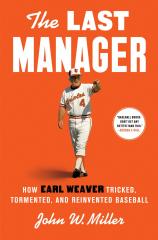The Last Manager: How Earl Weaver Tricked, Tormented, and Reinvented Baseball
Review
The Last Manager: How Earl Weaver Tricked, Tormented, and Reinvented Baseball
Earl Weaver was what is known as a “baseball lifer.” From the time he signed a minor league contract with his hometown St. Louis Cardinals in 1948 at the age of 17, he never had a full-time job outside the game. But like the majority of players at that time, he did have to supplement his income with off-season gigs like selling insurance and cars.
The tenacity and dedication that Weaver put into his craft, at the expense of his overall health and family life, make for one of the better baseball books in recent years.
"The tenacity and dedication that Weaver put into his craft, at the expense of his overall health and family life, make for one of the better baseball books in recent years."
Although a solid athlete, Weaver never made it to the Majors as a player, whether it was because of his small size (5’7”, barely 160 pounds) or the perception that he just wasn’t good enough, hampered by a weak arm and lack of speed. He had one shot to make it to the Cardinals following an impressive spring training, but his manager at the time added himself to the roster while cutting Weaver. Who knows what would have happened had he made good as a player?
Weaver became the manager of a low-classification minor league team at the age of 25 in 1956. By the time he was 37, he was at the helm of the Baltimore Orioles, leading the franchise to heretofore unknown success.
Journalist John W. Miller employs a year-by-year format in THE LAST MANAGER, all the while reporting on Weaver’s pugnacious attitude, which was both a help and a hindrance. He was a fierce umpire-baiter, finishing in fourth place when it came to managerial ejections. But he also was among the leaders in winning percentage and all-time victories.
Weaver was among the first to use a form of pre-sabermetric analytics before there were even personal computers. He kept track of how his hitters did against opposing pitchers (and vice versa for his own pitching staff). Whatever he was doing, it worked. Over his 17 years at the helm, he won six division titles, four American League pennants, and one World Series. His team won more than 100 games five times. He was a two-time Major League Manager of the Year and was inducted into the Baseball Hall of Fame in 1996.
Despite the comfort of success, Weaver was far from angelic. He was a borderline juvenile delinquent with a prominent uncle who was pretty high up in the St. Louis gambling scene. He also had a serious drinking problem. But at least he wasn’t as bad as his contemporary, Billy Martin, another talented manager who famously got into alcohol-fueled physical altercations with his own players as well as civilians.
In 2013, Weaver was on a Caribbean cruise for Orioles fans when he suddenly died at the age of 82. Miller does not get into much further detail about his passing.
The title of the book is about as perfect as you can get (even though my pet peeve is the use of superlatives). Although there are obviously still managers today, they do not have the same clout in this Moneyball, data-driven era where every stat and movement is analyzed. They also don’t have the leverage with high-salaried lineups.
“The popularization of analytics and probability theory in twenty-first century baseball…raised Earl Weaver’s profile,” Miller writes. “‘Weaver was the Copernicus of baseball,’ Tom Verducci had written in Sports Illustrated in 2009. ‘Just as Copernicus understood heliocentric cosmology before the invention of the telescope, Weaver understood smart baseball a generation before it was empirically demonstrated.’”
Reviewed by Ron Kaplan (www.RonKaplansBaseballBookshelf.com) on March 28, 2025
The Last Manager: How Earl Weaver Tricked, Tormented, and Reinvented Baseball
- Publication Date: March 4, 2025
- Genres: Biography, Nonfiction, Sports
- Hardcover: 368 pages
- Publisher: Avid Reader Press/Simon & Schuster
- ISBN-10: 1668030926
- ISBN-13: 9781668030929




